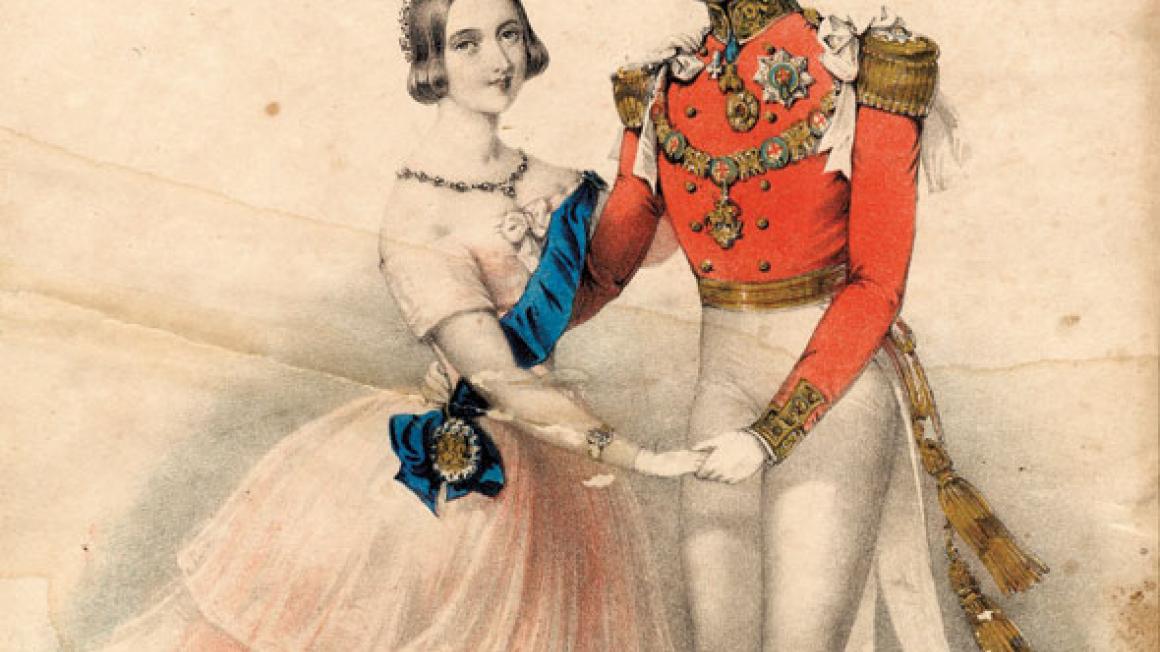Serving Victoria
In their family life, Victoria and Albert set out to create a model of domestic virtue, and similar standards of behaviour were expected from their court. When selecting her ladies and gentlemen the Queen generally looked to the lesser aristocracy, who, it was felt, were morally sounder and more sensible of the honour conferred on them than their wealthier, more fashionable counterparts.
‘Everything else changes, but the life here never does and is always exactly the same from day to day and year to year,’ wrote Georgy Liddell.
Life at Windsor proceeded with gentle monotony, as Charlotte Canning, 25-year-old lady of the bedchamber, recorded. Mornings, after prayers in the chapel and nine o’clock breakfast with the other ladies (a substantial meal of fowl, tongue, mutton cutlets and omelette), were taken up with correspondence, her own and the Queen’s. After luncheon she would wait in her rooms for ‘orders’, a note perhaps announcing that Her Majesty wished Charlotte, so long as she did ‘not object to an open carriage’ (objection of course was not an option) to accompany her on a drive, or a walk,or to ride out. Charlotte, to her relief, found that she was rarely required to ride (she preferred to walk) since there was usually a maid-of-honour ‘ready enough to think it an immense treat’.
Alternatively, Charlotte might find herself watching the royal couple go through their paces in the new riding school, or joining them for a game of skittles, or walking through the Home Park, which Albert was in the process of transforming and where he was keen to show o his projects. In addition to the riding school, he had built new stables, a dairy, an aviary, a mushroom house and kennels (complete with a dog hospital and a sitting room for the Queen’s use), where a Highland woman looked after rare breeds such as Cashmere or Chinese dogs. At the Home Farm, there were cows, pigs, poultry, pigeons and guinea pigs to be inspected. On Albert’s orders, old roads were diverted and new built. Lady Sarah Lyttelton, a lady-in-waiting who became superintendent of the nursery, declared herself delighted by a new carriage drive ‘up a steep hill round which we wound, to a tower called the clock tower which overlooks an ocean of fir trees, clothing a magnificent foreground and then Virginia Water and an immense blue distance – all quite a new part of the Great Park lately opened to carriages’.

It fell to Charlotte Canning to enforce the rules and regulations with which the maids-of-honour, only a few years younger than herself, were hedged about. In 1846 a ‘horrid’ set of new rules appeared ‘framed and glazed’ in the ladies-in-waiting room: maids were forbidden to leave the castle before lunch and only afterwards if there were no orders from the Queen. If alone they could go no further than the parapet on the East Terrace. This made Windsor ‘really feel like a prison’, wrote Eleanor Stanley, another lady-in-waiting, who hoped the new rules might be relaxed since both Charlotte Canning and Sarah Lyttelton thought them absurd.
The presence of Albert did not make for livelier evenings. The Prince had quickly grown bored of gossip and chess, and wanted ‘to bring literary and scientific people about the Court, vary the society and infuse a more useful tendency into it’. However he met resistance from the Queen who ‘had no fancy to encourage such people’, since she felt her education had ‘not fitted her to take part’ in intellectual conversation. Sarah Lyttelton may have detected a loftier tone of conversation around the dinner table, but Charlotte greatly regretted that potentially controversial and interesting subjects – politics, for example – were shunned in favour of safe platitudes. ‘One could never hear anything’ at court, she grumbled, ‘as those who could tell one were all on their good behaviour’.
After dinner, in the drawing room (the white or green drawing room when the party was a large one) Charlotte generally joined the Queen’s table, or made up a whist four with the Duchess of Kent. Otherwise she sat with the maids-of-honour, busying herself with needlework, or playing patience or solemnly watching the royal card game, or Albert at his fourhanded chess. Cards (commerce, vingtet-et-un or bagatelle) and dancing (quadrilles or country dances) – at least provided some relief from desultory conversation. Nain Jaune (Pope Joan), a game introduced in 1841, played for small sums (any coins given to the royal couple had to be either new or first washed lest they sully the royal hands) became popular. Speculation, played at the royal table in 1843, left everyone ‘in fits’ of hilarity. Sunday evenings were given over to less frivolous spelling games.
The household may have yawned their way through Windsor evenings; not so the Queen, who, as a young woman, was easily, and frequently, amused. What could be more delightful than puzzles or spillikins, or singing duets, or merely sitting and gossiping with her ladies?
Georgy Liddell described an unusually ‘gay’ evening when Her Majesty, an enthusiastic dancer, had a polka lesson and the Prince began spinning counters, ‘so I took to spinning rings which you know I am adept at doing and the Queen was delighted. It always entertains me to see the little things that amuse Her Majesty and the Prince, instead of their looking bored as people so often do in English society’.
Serving Victoria: Life In The Royal Household, by Kate Hubbard, is published on 18 October by Chatto & Windus, priced £20.


